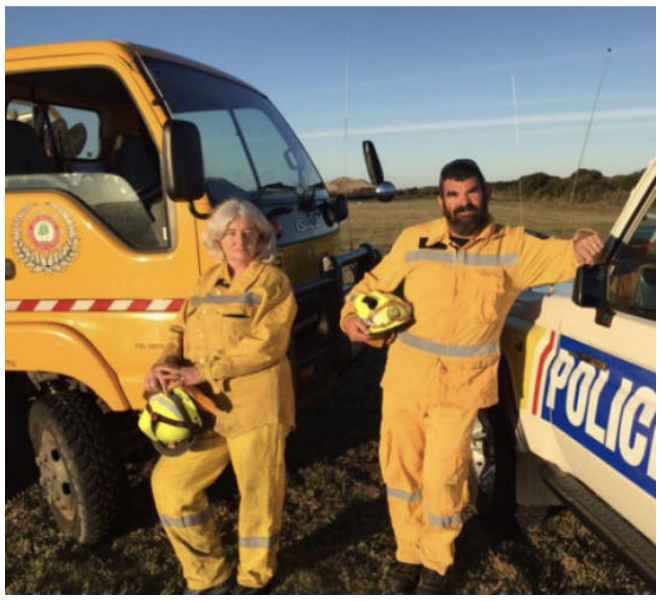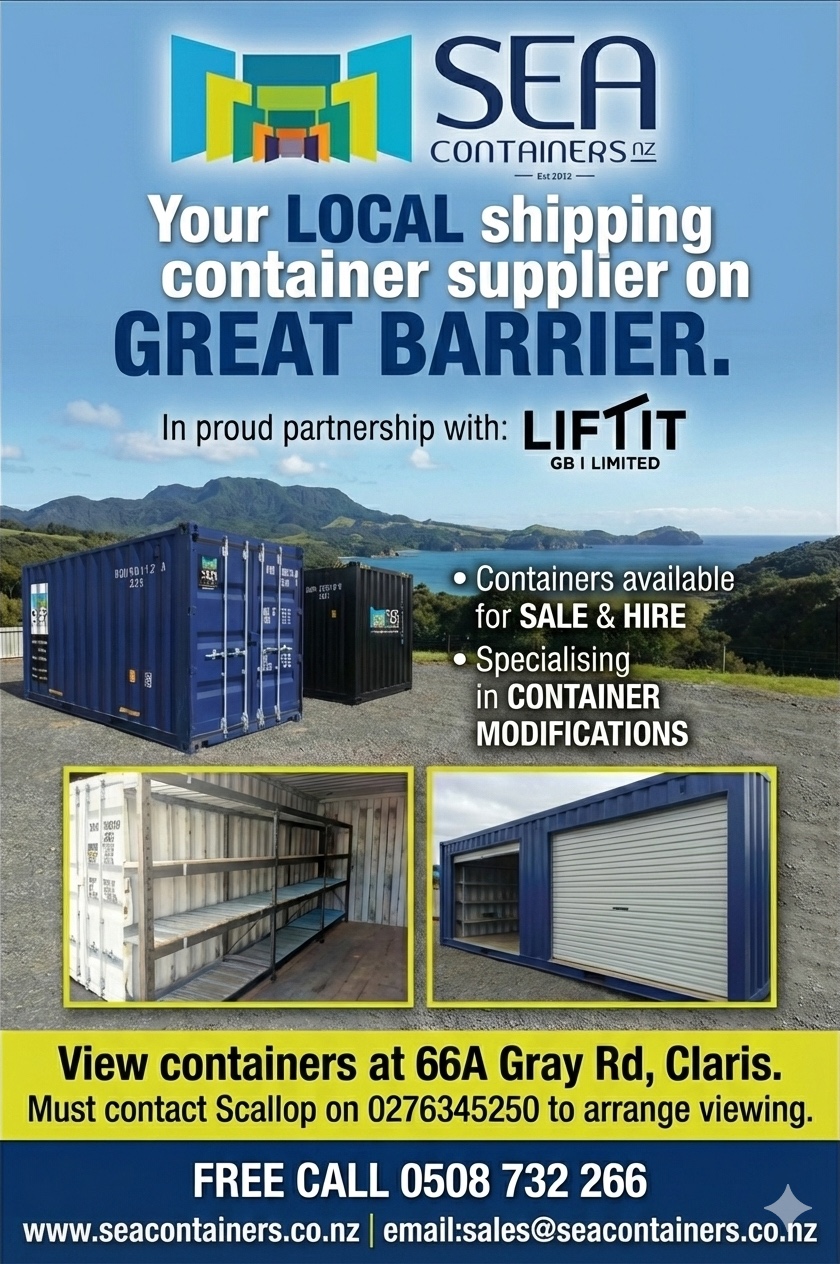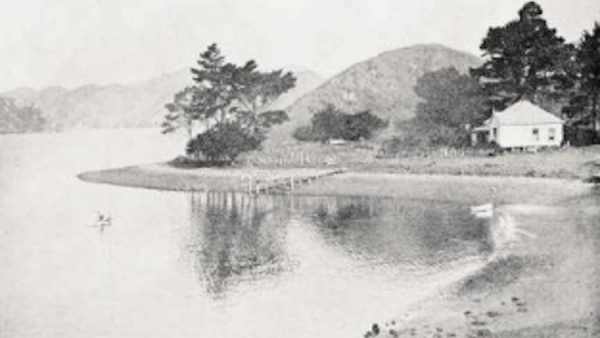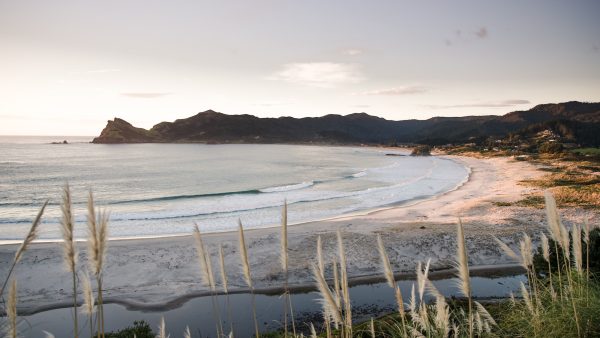Roger Bright and Kylie Robbins didn’t start out to be Great Barrier Island’s 24/7 superhero duo – it just turned out that way. They are the island’s two-man police force, firefighters in the local RFF, volunteer ambulance drivers, and skippers for the local coastguard.
Eighteen years ago, Roger got a transfer from the Ruatoria police station to Great Barrier to give his daughters a better life and quickly learned that the East Coast didn’t have exclusive use of the word ‘isolated’. The island is totally off-grid, but his daughters can hunt, surf, fish, and dive…
He tried to avoid joining the rural fire force in the beginning because he was sole charge and had to attend fires, accidents, and other police activities, but after 18 months on the island, he relented. Both Roger and Kylie trained to the point of Level 4 Certificate in Fire and Rescue Services – Vegetation, and Kylie has recently completed the New Zealand Safety Advisors Course for Fire, which will take her away from the humping hoses side of the job into more of the management role. Neither of them has sought rank in the RFF system. “I believe it is important to be able to work both at the coal face as well as in a position of decision-making,” said Roger. “It also allows other volunteers in our community to step up and take charge, thus not limiting the ‘rank’ levels to a very small group of people. We all get on really well together and I am more than happy taking orders, as I am distributing them.”
The Barrier RFF has five stations at strategic points on the island – Tryphena, Kaitoke (nearest for Roger and Kylie), Okupu, Awana, and Okiwi. Each has an appliance and a division of gear and a 50-strong pool of firefighters spread around. “All volunteers carry a pager and most have radios (but not all). Once the pager goes off, one of 3-4 people on the island ring FireComms and ascertain that problem, location, etc. Based on this info, the DPRFO (or whoever is the most senior on the island) directs resources as required… all stations turnout versus perhaps only one or two stations depending on the situation,” said Roger.
Due to their ability to deploy quickly (the island’s police vehicles always carry all the gear for the different roles the couple play), Roger and Kylie quite often are the first to respond and usually one of the first on the scene and providing sit-reps, etc. back to whoever is running the incident … “It works well,” he said.
Kylie grew up on the Barrier in a one-room hut with no running water but left as a teenager and worked in the Auckland courts before becoming a police officer 23 years ago. When Roger made the case for a second officer, she successfully applied for it and arrived in 2003. They were married in 2012. She joined the Police in 1993 and was stationed at Lower Hutt. “It didn’t take long for me to realize that I was not a ‘city’ cop, and I started rural policing as soon as I could get out of ‘Dodge’ – working in Orewa, then Wellsford, with a six-month stint skippering a Police RHIB (Rigid Hulled Inflatable Boat) for the 2003 Americas Cup.” Then she arrived back home on the island to take up the second constable’s job.
Kylie joined the brigade in 2003. “When I first started I was made a part of the Kaitoke crew, which consisted of my now husband Roger, and our neighbour and best friend Wayne Sanderson. Our PRFO Lance Dixon decided to schedule a Wajax competition which both Roger and Wayne were determined to win – they are both extremely competitive so we ended up drilling most afternoons after work for a while, and I wondered what I had got myself into. But it was the best foundation I could have asked for to establish those basic firefighting pump skills, and that has stood me in good stead ever since.”
It’s a tight-knit community – so much so any reliever for the two senior constables usually ends up taking messages for them to follow up when they return. Every so often they have to hand out traffic tickets to mates, but that is part and parcel of island life. The constables can’t escape who they are, or that they are in a de facto 24/7/365 job, so everyone has to learn the difference of talking to the policemen in the course of their duty, and when they are down at the club (usually drinking ginger ale). It is a rare occasion when they can get through a dinner party without leaving their guests to look after themselves.
“That is just the way the job is,” said Kylie. “Being one of the few government representatives on the island, we get phone calls or personal visits or visits to the station, with people asking all manner of things.”

Roger and Kylie aren’t actually part of St John Ambulance – it was only established in recent years. “Prior to that, the Police trucks were considered the island’s ambulances – both are kitted out to carry a stretcher, and it is only just recently that we have removed the actual stretchers from where they were tied behind the driver’s seat in the trucks,” said Kylie. “I remember the first time I heard a siren going past the Police station, and it was not myself or Roger driving. It was a really weird feeling to see the new ambulance heading off to an emergency/medical situation that we were not part of!”
“Obviously in our job we are first on the scene on many occasions – but we just do the basics till one of the medical team arrives. We are blessed with an incredible local medical team who turn out at a moment’s notice, and I have helped the doctor and nurses in all sorts of places from the middle of the bush to the stream under a stone road bridge.” However, the constables are still the off-road ambulance drivers using the 4×4 vehicle to get to places the normal ambulance can’t. “We have extra holding points fitted for holding up the likes of saline bags, etc., where/when they are required,” said Roger, “as well as lots of extra lighting in the rear of the vehicle for when we have a doctor or a nurse tending to a patient while we are driving, usually to either the local medical centre or somewhere where the rescue helicopter can land.”

As part of their policing role, the couple is required to qualify and then refresh their 4×4 driving skills for not only policing, but obviously the ambulance, search and rescue, fire, and all the other roles they fill on the island.
When Roger arrived on the island, the Police had no means of getting to the outer islands or attending any sort of marine search and rescue. A successful business case resulted in a new surf rescue inflatable – but that required Roger obtaining his Local Launch Operators ticket. “A couple of years later I was roped into assisting with a local Rescue Trust that raised money and obtained a craft for the island – an 8.5m Protector RHIB. Later we joined the Coastguard proper and all our assets were given over to the organization.” They now have a 12.5m Rayglass Protector, and Roger has his Coastguard Senior Masters ticket.
“We have to continue doing various training to this day to retain the qualification. I am also the ‘Master’ of the vessel for which it is my responsibility to keep the vessel up to a safe ‘survey’ standard for all our crew to use.” Being a yachtie, Kylie has been involved with Coastguard in one way or another since the mid-1990s when she was living in Öpötiki and was the secretary/treasurer and a crew member.
“When I came back to the Island in 2003, I became a crew member for the local Great Barrier Rescue and took on the Coastguard training officer’s role – a role which I have held with a couple of breaks since then and am forever trying to get rid of.”
Kylie has her Maritime NZ qualifications – Boat Masters and NZ Coastal Skippers tickets 1997 and commercial LLO – Local Launch Operators certificate. She also holds particular Coastguard tickets – Coastguard Senior Master. “I also have a Marine Search and Rescue Controllers qualification which I qualified for in 2003.”
Work and life are varied for Kylie and Roger; they get to jump out of helicopters during water rescues and have the bomb squad over to dispose of washed-up unused or misfired flares – a relatively common occurrence.
Callouts vary widely. “Sometimes you will go weeks without one; sometimes you will get two in a night,” said Kylie. A very rough estimate would be 18-20 police calls, half a dozen fires, a couple of ambulance calls, and at least 15 to 20 coastguard callouts per year.
The couple wears two hats all the time. “When I go to a fire, I am also, and predominantly, the cop, so the policing role regarding evacuation or traffic control has to come first,” said Kylie. That seems to work on the island. “Since we are always on call in our normal day-to-day life and we take the police truck to the fire, we are often there first. We can give the sit. rep, then help whichever fire appliance arrives first to set up and get sorted before one of us peels off into the cop role if that is needed,” said Kylie.
As regards Coastguard, a rescue is a rescue. A body recovery is a Coastguard and Police job, and both roles work together, she said. The Police oath “To Protect Life and Property” fits well with all the other roles, as it is first and foremost always, so it just seems to happen without being something I think about a lot, she said.
Roger said wearing multiple hats requires prioritising. “Sometimes what might start off as a fire job turns into a police job; same with Coastguard and ambulance. Sometimes you have to be wearing more than one hat and then it all gets sorted out later in the paperwork! It’s about prioritising the immediate response/work type, which depends on the individual incident and we all know no two are ever the same, requiring that constant re-evaluation and apportioning of the (in our case) appropriate ‘hat’.”
The Police Toyota Landcruiser troop carrier gets used as a police vehicle, a fire appliance, an ambulance, a tow truck, and has even been a hearse.
The Down Side
Being tight-knit can have its downside. When Kylie arrived as the new constable, Roger took her on the rounds. Much tea was drunk, and residents pulled out the photo albums (to her distress) to show him the younger Kylie. Now that Roger has been there for a few years, they both have the emotional problem of knowing almost any victim. “Wearing so many different hats means that generally, we are going to attend them all,” said Roger. “Fires, drownings, death (by whatever cause), MVAs, serious domestic incidents, search and rescues, and even some of the serious out-and-out plain old accidents. The flip side is that having been here for so long and knowing most people, having the local knowledge and contacts is invaluable.”
What do they do with that rarest of commodities – time off? They both enjoy hunting, which has the additional benefit of filling the freezer. They also dive and fish. Kylie gardens, sews, and watches The Walking Dead on TV. She was doing a ‘back to bare hull’ renovation of a 38ft yacht until it fell off its cradle and was destroyed. Now she is working on a couple of sailing dinghies. Every so often they manage to get off the island for a break, which serves to remind them how much they like the island life…
What Roger forgot to mention in the interview is that he is a holder of the New Zealand Bravery Medal awarded for using an axe to break down a door, and without BA, rescue a resident from a gas-filled building on Great Barrier. Also omitted were the Royal Humane Society Bronze Medals awarded to the couple for the off-duty rescue of youngsters from a rip off Kaitoke Beach on the island.
The Big Fire
Kylie and Roger have war stories covering most subjects, including plane crashes next door and braving bee swarms. But the big one for both of them is the big scrub fire of 2013 that took out about 115 hectares. All the worst stuff seems to happen when Roger leaves Great Barrier Island, and it has become a standing island joke.
In 2013 Roger and Kylie were off-Island putting their son Ben into school (his first year at Tauranga Boys). Kylie said they got a phone call from her mother (who was living on the island next door to them) to say they were being evacuated as the fire was heading towards the police station and houses and asking what we wanted to be taken from the house?
“I wanted her to go to the station, open the window, and throw all my overdue files out to burn, but apparently, she wasn’t too keen on that. Poor Ben got dumped in Tauranga, and Roger and I headed for home as fast as we could. Meantime, the relieving police officer, Constable Yi Fong – known to us as Ed – had managed to get some of the boys from Auckland over to the Barrier to help him out with evacuations, etc. They took one of the trucks out and left the second truck loaded with the radios, firearms, and everything else they could get out of the station, parked up ready to go at a moment’s notice – as by this time the fire was sweeping over the swamp across the road from the police station.

“Three local men who shall remain nameless, arrived at the station somewhat worse for wear and used the station ladder to climb up onto the roof of the police station where they proceeded to continue to have a few drinks and enjoy the show. As the fire got closer, they decided it was their community duty to look after Roger and Kylie’s stuff, so they rushed off to the police house, threw the gate off its hinges, and hooked Roger’s boat onto the back of the police truck. They took off in the truck with dive tanks and fishing rods flying off everywhere and drove through the paddocks to the neighbours where they dumped the boat off and proceeded down to the airport where they ran into the actual police who were less than pleased that they had appropriated the truck, and removed them from it promptly.
“At this point, the men jumped back onto their truck (complete with gas tanks on the back) and drove across the airfield to get a closer look at the fire front. Somehow they survived and got unceremoniously packed off home,” said Kylie.
Roger and Kylie got the first flight home and arrived back on the island the next morning. “As I got off the plane, Ed was waiting to meet us. I said: “Ed, what are you doing – we leave you to look after our island for a couple of days and look what you do to it!” He looked me up and down and called back: “Typical – blame the Asian,” a comment the locals thought was hilarious and managed to make him one of the most well-loved police relievers the Island has had.”
The fire was still going strong and Roger and Kylie proceeded to spend the next week working their police job for eight hours a day followed by a night shift on the fire line.
Reproduced with permission from K1 Group – Subject to copyright in its entirety. Neither the photos nor the text may be reproduced in any form of advertising, marketing, newspaper, brochure, leaflet, magazine, other websites or on television without permission from K1 Group.







